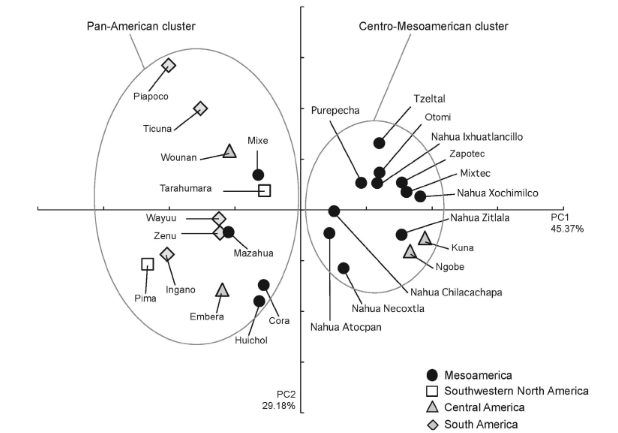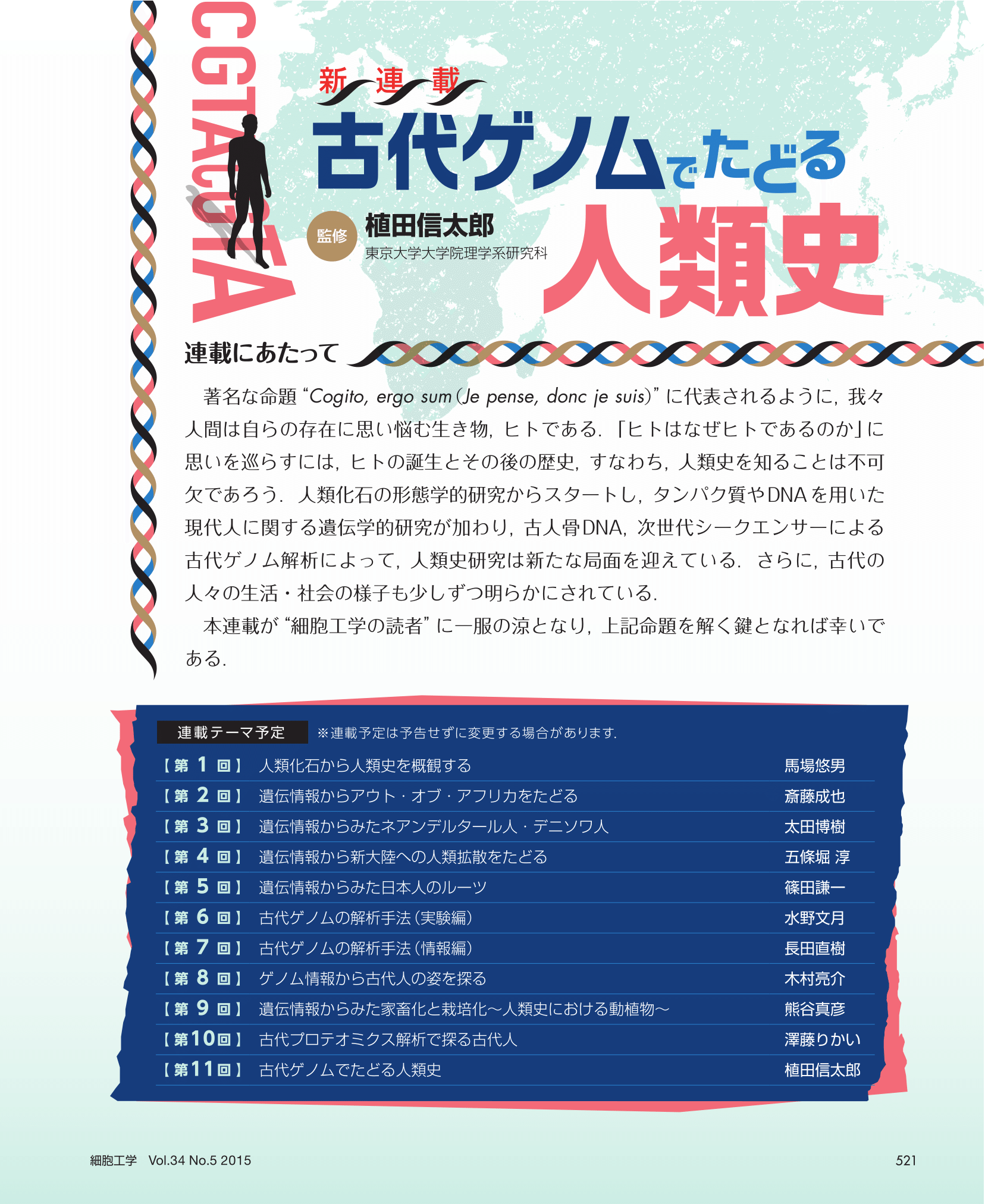Information
- 平成30年3月23日(金)13:30-15:30に理学部2号館講堂で植田信太郎教授の最終講義が行われます。[2018/3/22]
- 橋詰晃一、石谷孔司が博士(理学)の学位を取得しました。[2018/3/22]
- 日本DNA多型学会第26回学術集会で石谷孔司が優秀研究賞を受賞しました。[2017/12/1]
- 北米神経科学学会(Neuroscience 2017)で橋詰晃一がポスター発表を行いました。[2017/11/11-15]
- 橋詰晃一のPOU3F2単一アミノ酸反復配列に関する論文が公開されました。詳細はこちら。[2017/8/30]
- 日本進化学会第19回大会で橋詰晃一が口頭発表を行いました。[2017/8/24-26]
- Publications(掲載論文)を更新しました。[2017/8/17]
- 日本生理人類学会若手の会第28回若手研究者講演会の招待講演にて石谷孔司が講演を行いました。[2017/6/23]
- 石谷孔司が開発したヒトミトコンドリアゲノム統合解析ツールMitoSuiteの論文が公開されました。詳細はこちら。[2017/05/30]
- 澤藤りかいさんが琉球大学大学院医学研究科人体解剖学講座へ異動されました。新天地でもご活躍されることをお祈りしております。[2017/04/01]
- Oxford大学、Uppsala大学での生物人類学セミナー(北方圏における人類生態史総合研究拠点)に澤藤りかいが参加しました。[2017/01/13-16]
- 第39回日本分子生物学会年会で橋詰晃一、石谷孔司がポスター発表を行いました。[2016/11/30-12/2]
- Chile-Japan Academic Forum 2016(チリ・パタゴニア)で石谷孔司が口頭発表を行いました。[2016/11/5-11/16]
- 第70回日本人類学会大会で澤藤りかいが口頭発表、石谷孔司が口頭発表・ポスター発表を行いました。[2016/10/8-10/10]
- Members(所属先)・Publications(掲載論文)を更新しました。[2016/09/13]
- WAC8(the Eighth World Archaeological Congress)で澤藤りかいが口頭発表を行いました。[2016/08/26-09/02]
- 日本進化学会第18回大会で橋詰晃一がポスター発表を行いました。[2016/08/25-28]
- 人類学若手の会 第4回総合研究集会で石谷孔司がポスター発表を行いました。[2016/02/06-07]
- 細胞工学2016年2月号に澤藤りかいが担当した「古代プロテオミクス解析で探る古代人」が掲載されました。詳細はこちら。[2016/02]
- Oxford大学、Uppsala大学での生物人類学セミナー(北方圏における人類生態史総合研究拠点)に澤藤りかいが参加しました。[2016/01/09-17]
- BMB2015で橋詰晃一、石谷孔司がポスター発表を行いました。[2015/12/01-04]
- NGS現場の会(第四回研究会)で澤藤りかいがポスター発表を行いました。[2015/07/1-3]
- 国際ゲノム会議(The 11th International Workshop on Advanced Genomics)で石谷孔司がポスター発表を行いました。[2015/05/20-22]
- 細胞工学にて植田信太郎教授監修「古代ゲノムでたどる人類史(全11回)」の連載が始まります。詳細はこちら。[2015/04/27]
- ウェブページを一新しました。[2015/04/01]
Studies
分子進化学研究 | 単一アミノ酸反復配列の表現型解析
脳は脊椎動物になって初めて、大脳、間脳、中脳、小脳、橋、延髄という現在見られる分節構造をとり、中枢神経系として機能するようになりました。その後、爬虫類から哺乳類に至る過程で大脳新皮質を獲得し、ヒト科まで続く脳容量の拡大が始まります。ヒト科では連合野が発達し、高次精神機能を有するに至ったと考えられています。このように、脳は脊椎動物における進化の過程で形態(マクロ)的に大きな変化を遂げているのですが、それを支える分子(ミクロ)的変化については、いまだ分かっていないことが多く存在します。私たちは、爬虫類から哺乳類にかけて数が明らかに増加する単一アミノ酸反復配列がそのような分子的変化の一翼を担っているのではないかと考え、研究を行っています。

Nasu et al., (2014) Fig.2A
分子人類学研究 | 古人骨ゲノム解析
現生人類は、数万〜数十万年前のアフリカ(〜パレスチナ)が起源とされています。その後、世界各地で適応放散し、現在見られるような人類集団を形成したと考えられています。しかし、その適応放散がどのようにして為されていったのかについて、いまだに解明されていない点が多く存在します。この理由として、これまでの人類学的研究は化石記録に頼る他なく、その多くが断片的な情報であったことがあります。しかし、1980年代の分子生物学的手法の進歩は、出土する骨からのDNA解析を可能にし、古代人類に関して様々な遺伝情報を得ることが出来るようになりました。近年では、高出力型のDNAシーケンサを用いたゲノム解析が可能となり、これまで以上に多くの知見を得ることが出来るようになりました。私たちの研究室では、こうした分子生物学的手法や最先端の解析技術を駆使することで、古代人類の遺伝的背景を明らかにするとともに、現代の人々との比較により適応放散に関する新たな知見を導き出そうとしています。

Mizuno et al., (2014) Fig.5
ゲノム進化学研究 | 大規模ゲノム解析
分子進化を探るにあたって、一つ一つの遺伝子に着目してその進化を明らかにすることは非常に重要なことです。 しかし、その一方で、全体を見渡して初めて明らかになることもあります。 近年では、国際的なプロジェクトが立ち上がり、脊椎動物を始め、様々な動植物の全ゲノム塩基配列の解読が進んでいます。 2003年にはヒトの全ゲノム塩基配列解読終了の宣言があり、また、マウス、フグでも大部分のゲノム塩基配列が決定されました。 近年では、高出力型のDNAシーケンサの登場により、これまで以上にゲノム塩基配列の解析が進んでいます。 塩基配列はそのままでは単なる記号の羅列に思われますが、そこから得られる情報を詳細に比較解析することで、ゲノム進化に関する多くの知見を得ることが出来ます。 私たちの研究室では、この全ゲノム塩基配列を対象としバイオインフォマティクスの手法を用いて、ヒトの特異性、ひいては脊椎動物特異的な進化に関して新たな知見を導き出そうとしています。

©Togo picture gallery
Press Release
細胞工学掲載記事「古代プロテオミクス解析で探る古代人 」2016/02
古代プロテオミクスって何?古代DNAと何が違うの?どんなことが分かるの?という点についてまとめ、先行研究での事例も紹介しています。土器の内容物の解析、歯石から食物の解析など、手法としては分子生物学、興味としては考古学寄りな内容です。また、動物考古学の分野で最近流行りのZooMSについても簡単に説明を加えました。興味のある方はご連絡ください。
東京大学大学院理学系研究科 博士課程 澤藤りかい
細胞工学 新連載「古代ゲノムでたどる人類史」 2015/04
2015年5月号の細胞工学にて、植田信太郎教授が監修した「古代ゲノムでたどる人類史(全11回)」の連載が始まりました。注目が集まる古代ゲノム研究の最新情報を各専門家の方々が毎回分かりやすく解説をしています。

『著名な命題 " Cogito, ergo sum(Je pense, donc je suis) " に代表されるように、我々人間は自らの存在に思い悩む生き物、ヒトである。「ヒトはなぜ、ヒトであるのか」に思いを巡らすには、ヒトの誕生とその後の歴史、すなわち、人類史を知ることは不可欠であろう。人類化石の形態学的研究からスタートし、タンパク質やDNAを用いた現代人に関する遺伝学的研究が加わり、古人骨DNA、次世代シークエンサーによる古代ゲノム解析によって、人類史研究は新たな局面を迎えている。さらに、古代の人々の生活・社会の様子も少しすつ明らかにされている。本連載が“細胞工学の読者”に一服の涼となり、上記命題を解く鍵となれば幸いである。』
東京大学大学院理学系研究科教授 植田信太郎
連載テーマ予定
| 【第一回】 | 人類化石から人類史を概観する | 馬場悠男 |
| 【第二回】 |
遺伝情報からアウト・オブ・アフリカをたどる | 斎藤成也 |
| 【第三回】 |
遺伝情報からみたネアンデルタール・デニソワ人 | 太田博樹 |
| 【第四回】 | 遺伝情報からみた新大陸への人類拡散をたどる | 五條堀淳 |
| 【第五回】 |
遺伝情報からみた日本人のルーツ | 篠田謙一 |
| 【第六回】 | 古代ゲノムの解析手法(実験編) | 水野文月 |
| 【第七回】 | 古代ゲノムの解析手法(情報編) | 長田直樹 |
| 【第八回】 | ゲノム情報から古代人の姿を探る | 木村亮介 |
| 【第九回】 | 遺伝情報からみた家畜化と栽培化〜人類史における動植物〜 | 熊谷真彦 |
| 【第十回】 |
古代プロテオミクス解析で探る古代人 | 澤藤りかい |
| 【第十一回】 | 古代ゲノムでたどる人類史 | 植田信太郎 |
詳細は、出版社WEBページをご参照下さい。
Members
教授
植田 信太郎
東京大学大学院理学系研究科 教授
専門分野:分子人類学、分子進化学
連絡先:
客員共同研究員
須藤 伝悦
客員共同研究員
専門分野:神経科学、神経薬理学
連絡先:
院生
橋詰 晃一
博士課程4年
研究分野:神経科学、進化生物学
研究内容:転写因子Pou3f2内単一アミノ酸反復配列のin vivo解析
連絡先:
石谷 孔司 [Web管理者]
博士課程3年 日本学術振興会特別研究員DC1
研究分野:集団遺伝学、バイオインフォマティクス
研究内容:古代人類集団のゲノム解析、ゲノム解析ツールの開発
連絡先:
当研究室出身の研究者 / 博士号取得者(敬称略・五十音順)
- 五十嵐 惇
Johns Hopkins University School of Medicine (USA), Postdoctoral Fellow - 岩本 和也
熊本大学大学院生命科学研究部分子脳科学分野・教授 - 太田 博樹
北里大学・医学部・准教授 - 河村 正二
東京大学・大学院新領域創成科学研究科・教授 - 熊谷 真彦
国立研究開発法人 農業・食品産業技術総合研究機構・高度解析センター ゲノム情報大規模解析チーム - 黒崎 久仁彦
東邦大学・医学部・教授 - 黒崎 辰昭
University of Rochester Medical Center (USA), Research Assistant Professor - 五條堀 淳
総合研究大学院大学・先導科学研究科・講師 - 澤藤 りかい
琉球大学大学院医学研究科人体解剖学講座・研究員 - 隅山 健太
理化学研究所・生命システム研究センター・細胞デザインコア・高速ゲノム変異マウス作製支援ユニット・ユニットリーダー - 那須 信
熊本大学大学院・生命科学研究部・助教 - 早川 敏之
九州大学・基幹教育院・准教授 - 水野 文月
東邦大学・医学部・助教 - 茂谷(斉藤)久子
千葉大学・大学院医学研究科・助教 - 矢田 紗織
東北大学・農学部農学研究科・応用生命科学専攻・分子生物学分野・産学官連携研究員 - 黄 郁慈
中原大学(台湾)・工学院・准教授 - 渡邉 裕二
福島県立医科大学・医学部・助教 - 王 瀝
杭州師範大学・医学部・教授
ご所属に関しまして、異動・誤り等がございましたら、WEB管理者までご連絡下さい。
Publications
- 2017年
- 2016年
- 2015年
- 2014年
- 2013年
- 2012年
Nasu M, Mizuno F, Ueda S. (2012). Comparative aspects of polyglutamine binding domain in PQBP-1 among Vertebrata Gene 511.2:243-247.
Kurosaki T, Ueda S, Ishida T, Abe K, Ohno K, Matsuura T. (2012). The unstable CCTG repeat responsible for myotonic dystrophy type 2 originates from an AliSx element insertion into an early primate genome PLoS ONE 7(6):e38379.
Kurosaki T, Gojobori J, Ueda S. (2012). Comparative genetics of poly-Q tract of ataxin-1 and its binding protein PQBP-1 Biochemical Genetics 50, 309-317.
- 2011年
- 2010年
- 2009年
- 2008年
- 2007年
- 2006年
- 2005年
- 2004年
- 2002年
- 2001年
- 2000年
- 1999年
- 1998年
- 1997年
- 1996年
- 1995年
- 1994年
- 1993年
- 1992年
- 1991年
- 1990年
- 1989年
Hashizume K., Yamanaka M., and Ueda S. (2017). POU3F2 participates in cognitive function and adult hippocampal neurogenesis via mammalian-characteristic amino acid repeats. Genes, Brain and Behavior doi:10.1111/gbb.12408
Mizuno F, Wang, L, Sugiyama S, Kurosaki K, Granados J, Celta Gomez-Trejo C, Víctor Acuña-Alonzo V, and Ueda S. (2017). Characterization of complete mitochondrial genomes of indigenous Mayans in Mexico. Annals of Human Biology doi:10.1080/03014460.2017.1358393
Ishiya K and Ueda S. (2017). MitoSuite: a graphical tool for human mitochondrial genome profiling in massive parallel sequencing. PeerJ 5:e3406.
Sawafuji R, Cappellini E, Nagaoka T, Fotakis AK, Jersie-Christensen RR, Olsen JV, Hirata K, Ueda S. (2017). Proteomic profiling of archaeological human bone. Royal Society Open Science 4, 161004.
Mizuno F, Kumagai M, Kurosaki K, Hayashi M, Sugiyama S, Ueda S, Wang L. (2017). Imputation approach for deducing a complete mitogenome sequence from low-depth-coverage next-generation sequencing data: application to ancient remains from the Moon Pyramid, Mexico. Journal of Human Genetics 62(6):631-635.
Kanzawa-Kiriyama H, Kryukov K, Jinam TA, Hosomichi K, Saso A, Suwa G, Ueda S, Yoneda M, Tajima A, Shinoda K, Inoue I, Saitou N. (2017) A partial nuclear genome of the Jomons who lived 3,000 years ago in Fukushima, Japan. Journal of Human Genetics 62(2):213-221.
Kumagai M, Kanehara M, Shoda S, Fujita S, Onuki S, Ueda S, Wang L. (2016). Rice varieties in archaic East Asia: reduction of its diversity from past to present times. Molecular Biology and Evolution 33(10):2496-2505.
Gojobori J, Mizuno F, Wang L, Onishi K, Granados J, Gomez-Trejo C, Acuña-Alonzo V, Ueda S. (2015). mtDNA diversity of the Zapotec in Mexico suggests a population decline long before the first contact with Europeans Journal of Human Genetics 60, 557–559.
Nasu M, Yada S, Igarashi A, Sutoo D, Akiyama K, Ito M, Yoshida N, Ueda S. (2014). Mammalian-Specific Sequences in Pou3f2 Contribute to Maternal Behavior Genome biology and evolution 6.5: 1145-1156.
Mizuno F, Gojobori J, Wang L, Onishi K, Sugiyama S, Granados J, Gomez-Trejo C, Acuña-Alonzo V, Ueda S. (2014). Complete mitogenome analysis of indigenous population in Mexico: its relevance for the origin of Mesoamericans Journal of human genetics 59(7):359-67.
Kihana M, Mizuno F, Sawafuji R, Wang L, Ueda S. (2013). Emulsion PCR-coupled target enrichment: An effective fishing method for high-throughtput sequencing of poorly preserved ancient DNA. Gene 528.2:347-351.
Gojobori J and Ueda S. (2011) Elevated evolutionary rate in genes with homopolymeric amino acid repeats constituting non-disordered structure Mol. Biol. Evol. 28, 543-550.
Kumagai M, Wang L, Ueda S. (2010). Genetic diversity and evolutionary relationaships in genus Oryza revealed by using highly variable regions of chloroplast DNA Gene 462; 44-51.
Kurosaki T, Matsuura T, Ohno K, Ueda S. (2009). Alu-mediated acquisition of unstable ATTCT pentanucleotide repeats in the human ATXN10 gene Mol. Biol. Evol. 26(11), 2573-2579.
Kurosaki T, Matsuura T, Ohno K, Ueda S. (2008). Long-range PCR for the diagnosis of spinocerebellar ataxia type 10 Neurogenetics 9(2), 151-152.
Gojobori J, Tang H, Akey JM, Wu CI. (2007). Adaptive evolution in humans revealed by the negative correlation between the polymorphism and fixation phases of evolution, Proc. Natl. Acad. Sci. USA 104(10), 3907-3912.
Anan K, Yoshida N, Kataoka Y, Sato M, Ichise H, Nasu M, Ueda S. (2007). Morphological Change Caused by Loss of the Taxon-Specific Polyalanine Tract in Hoxd-13, Mol. Biol. Evol. 24 (1), 281-287.
Kurosaki T, Ninokata A, Wang L, Ueda S. (2006). Evolutionary scenario for acquisition of CAG repeats in human SCA1 gene, Gene 373, 23-27.
Huang YT, Iwamoto K, Kurosaki T, Nasu M, Ueda S. (2005). The neuronal POU transcription factor Brn-2 interacts with Jab1, a gene involved in the onset of neurodegenerative diseases, Neurosci. Lett. 382(1-2), 175-178.
Kurosaki K, Wang L, Tang J, Wang W, Saitou N, Endo T, Ueda S. (2005). Identification of a bronze weapon based on an embedded fragment in a 3000-year-old skull, Forensic Sci. Int. 151, 105-108.
Kitano T, Liu YH, Ueda S, Saitou N. (2004). Human-specific amino acid changes found in 103 protein-coding genes, Mol. Biol. Evol. 21(5), 936-944.
Sumiyama K, Saitou N, Ueda S. (2002). Adaptive evolution of the IgA hinge region, Mol. Biol. Evol. 19, 1093-1099.
Oota H, Kitano T, Jin F, Yuasa I, Wang L, Ueda S, Saitou N, Stoneking M. (2002). Extreme mtDNA homogeneity in Continental Agian popukations, Amer. J. Phys. Anthropol. 118(2), 146-153.
Oota H, Saitou N, Ueda S. (2002). A large-scale analysis of human mitochondrial DNA sequences with special reference to the population history of East Eurasian, Anthropol. Sci. 110 (3): 293-312.
Oota H, Korosaki K, Pookajorn S, Ishida T,Ueda S. (2001). Genetic study of the Paleolithic and Neolithic Southeast Asians, Human Biol. 73(2), 225-231.
Noda R, Kim CG, Takenaka O, Ferrell RE, Tanoue T, Hayasaka I, Ueda S , Ishida T, Saitou N. (2001). Mitochondrial 16S rRNA sequence diversity of hominoids, J. Hered. 92 (6), 490-496.
Iwamoto K, Huang Y-T, and Ueda S. (2000). Genomic organization and alternative transcripts of the human PQBP-1 gene, Gene 259(1/2), 69-73.
Wang L, Oota H, Saitou N, Jin F, Matsushita T, Ueda S. (2000). Genetic structure of a 2500-year-old human population in China and its spatiotemporal changes, Mol. Biol. Evol. 17(9), 1396-1400.
Oota H, Saitou N, Matsushita T, Ueda S. (1999). Molecular genetic analysis of remains of a 2,000-year-old human population in China - and its relevance for the origin of the modern Japanese population, Am. J. Hum. Genet. 64 (1), 250-258.
Sumiyama K, Kawamura S, Takenaka O, Ueda S. (1998). A high sequence variety in the immunoglobulin C-alpha hinge region among old world monkeys, Anthropol. Sci. 106 (1), 31-39.
Sumiyama K, Washio-Watanabe K, Ono T, Yoshida MC, Hayakawa T, Ueda S. (1998). Human class III POU genes, POU3F1 and POU3F3, map to Chromosomes 1p34.1 and 3p14.2, Mamm. Genome 9 (2), 180-181.
Saitoh H, Ueda S, Kurosaki K, Kiuchi M. (1998). The different mobility of complementary strands depends on the proportion AC/GT, Forensic Sci. Int. 91 (2), 81-90. (correction: 94 (1-2), 155-156.)
Nakachi Y, Hayakawa T, Oota H, Sumiyama K, Wang L, Ueda S. (1997). Nucleotide compositional constraints on genomes generate alanine-, glycine-, and proline-rich structures in transcription factors, Mol. Biol. Evol. 14 (10), 1042-1049.
Kurosaki K, Saitoh H, Oota H, Watanabe Y, Kiuchi M, Ueda S. (1997). Combined polymorphism associated with a 3-bp deletion in the 5'-flanking region of a tetrameric short tandem repeat at the CYP19 locus, Japanese Journal of Legal Medicine 51 (3), 191-195.
Watanabe Y, Sakazume T, Kurosaki K ,Oota H, WashioWatanabe K, Ueda S. (1997). No directionality of short tandem repeat evolution at the HPRT locus in catarrhine primates, Folia Primatol. 68 (6), 350-353.
Watanabe Y , Sakazume T, Kurosaki K, Oota H, Washio-Watanabe K, Ueda S. (1996). Short tandem repeat polymorphisms in Japanese macaques: Their short repeat lengths and low informativeness, Mamm. Genome 7 (5), 383-385.
Sumiyama K ,Washio-Watanabe K, Saitou N, Hayakawa T ,Ueda S. (1996). Class III POU genes: Generation of homopolymeric amino acid repeats under GC pressure in mammals, J. Mol. Evol. 43 (3), 170-178.
Tanabe H, Ishida T, Ueda S , Sofuni T, Mizusawa H. (1996). Molecular anatomy of human chromosome 9: Comparative mapping of the immunoglobulin processed pseudogene C epsilon 3 (IGHEP2) in primates, Cytogenet. Cell Genet. 73 (1-2), 92-96.
Kurosaki K ,Oota H, Saitoh H, Kiuchi M, Ueda S. (1996). Sequence variation found in the flanking region of a trimeric short tandem repeat at the PLA2 locus: its considerable effect on estimating alleles, Japanese Journal of Legal Medicine 50 (1), 1-5.
Oota H, Saitou N, Matsushita T, Ueda S. (1995). A genetic-study of 2,000-year-old human remains from japan using mitochondrial-DNA sequences, Amer. J. Phys. Anthropol. 98 (2), 133-145.
Tanabe H, Ishida T, Ueda S , Sofuni T, Mizusawa H. (1995). Comparative mapping of the immunoglobulin C-epsilon-1 gene (IGHE) in 5 species of nonhuman-primates by fluorescence in-situ hybridization, Cytogenet. Cell Genet. 70 (3-4), 239-242.
Watanabe Y and Ueda S. (1995). Characterization of human-specific DNA regions obtained by genome subtraction, Human Evolution 10 (1), 63-68.
Saitou N and Ueda S. (1994). Evolutionary rates of insertion and deletion in noncoding nucleotide-sequences of primates, Mol. Biol. Evol. 11 (3), 504-512.
Kurosaki K, Matsushita T, Ueda S. (1993). Individual DNA identification from ancient human remains, Am. J. Hum. Genet. 53 (3), 638-643.
Kawamura S, Saitou N, Ueda S. (1992). Concerted evolution of the primate immunoglobulin alpha-gene through gene conversion, J. Biol. Chem. 267 (11), 7359-7367.
Kawamura S, Ueda S. (1992). Immunoglobulin CH gene family in hominoids and ith evolutionary history, Genomics 13 (1), 194-200.
Kawamura S, Tanabe H, Watanabe Y, Kurosaki K, Saitou N, Ueda S. (1991). Evolutionary rate of immunoglobulin-alpha noncoding region is greater in hominoids than in old-world monkeys, Mol. Biol. Evol. 8 (6), 743-752.
Ueda S, Washio K, Kurosaki K. (1990). Human-specific sequences: isolation of species-specific DNA regions by genome subtraction, Genomics 8 (1), 7-12.
Kawamura S, Omoto K, Ueda S. (1990). Evolutionary hypervariability in the hinge region of the immunoglobulin alpha-gene, J. Mol. Biol. 215 (2), 201-206.
Kawamura S, Omoto K, Ueda S. (1989). Nucleotide-sequences of the gorilla immunoglobulin alpha-1 gene, Nucleic Acids Res. 17 (16), 6732-6732.